The digital technology revolution has brought about an all pervasive affect on our lives and has not only changed, but continues to change the way we think, work, communicate and even socialise.
In this post I have tried to identify the birthplaces of some of the digital technology giants or technological innovations which have played a major role in bringing about this digital revolution. Few of these giants started from a very small workplace (such as a garage) and rose to an unimaginable height of fame.
Present list which is not exhaustive, starts from the oldest to the newest and includes following firms / innovations / products;
- International Business Machines Corp (IBM)
- Hewlett-Packard Co.
- World's First Hard Disk, IBM RAMAC 350
- WYSIWYG (What You See Is What You Get) and GUI (Graphical User Interface)
- Microsoft Corporation
- Apple Inc.
- First IBM-PC
- Dell Inc.
- World Wide Web (Hypertext Protocol)
- Google Inc.
Wherever possible I have also shown the birthplaces from Google Street View, failing which I have resorted to MSN Bing Aerial View and/or some other image of the location.
I seek comments/suggestions from my readers for adding more birthplaces of other digital technology firms/technologies which in their opinion played a major role in present day digital revolution.
The oldest, one of the biggest technology company and most famous brand name which is globally synonymous with the word computer, IBM has a continuous history dating back to the 19th century. It had its beginning in the present form at Endicott on February 14, 1924, when the name of erstwhile Computing Tabulating Recording (CTR) Corporation name was formally changed to International Business Machines Corporation (popularly known as IBM). CTR itself was amalgamation of three different companies: the Tabulating Machine Company (with origins in Washington, D.C. in the 1880s), the International Time Recording Company (founded in 1900 in Endicott), and the Computing Scale Corporation (founded in 1901 in Dayton, Ohio). In a sense Endicott is the birthplace of this multinational technical giant.
Although in 1964 IBM moved its headquarters and Main plant to Armonk, NY, it still maintains some limited operations at the Endicott plant which was once known as Plant Number One.
It was at Endicott in 1956 that World’s first Hard Disk Drive known as IBM Disk Storage Unit RAMAC 350 was released as a part of the IBM 305 RAMAC (Random Access Method of Accounting and Control) computer. The disk however was conceived at IBM's West Coast Laboratory at San Jose.
Aerial view of IBM Endicott Plant in 1929;
Image from IBM Archives is Copyright © IBM and included here after due permission.
Present day views;

Image Source: MSN Bing Aerial View

Image Source: Google Street View
Strangely for some unknown reason the Google Earth has blurred view of IBM plant area.
Source of info and more info: IBM History / Wikipedia
Hewlett-Packard Co. - Garage at 367 Addison Avenue, Palo Alto, CA.
Hewlett-Packard Company commonly (commonly referred as HP) is ranked as one of the world's largest information technology companies. It had a modest beginning in a small Garage in Palo Alto taken on rent in 1938 by HP's co-founders Dave Packard Bill Hewlett. Dave and his newly wed bride used the first floor of the3-room apartment while Bill used the shed at the back of the apartment as his bedroom.
The Garage was their workshop cum factory where HP's first product - an audio oscillator was built. Walt Disney Studios were their first customer and had purchased eight oscillators to test and certify the sound systems in theatres that were going to run their first major film released in stereophonic sound, Fantasia.
Although HP entered in Digital technology much later however they are recognized as the symbolic founder of Silicon Valley and the Garage which is included in U.S. National Register of Historic Places is listed as Birth place of Silicon Valley. In year 2000 HP purchased the property and have preserved it as a private museum.

Image Source: Google Street View

Image Source: Google Aerial View
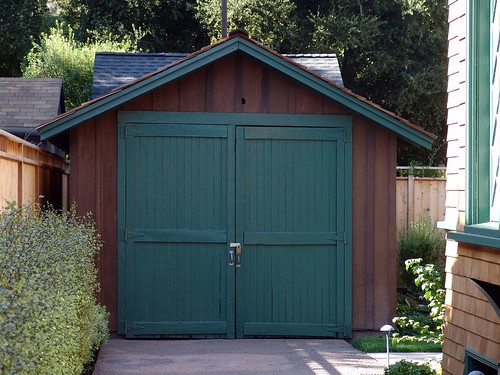
Image from Flickr is by Joachim S. Müller
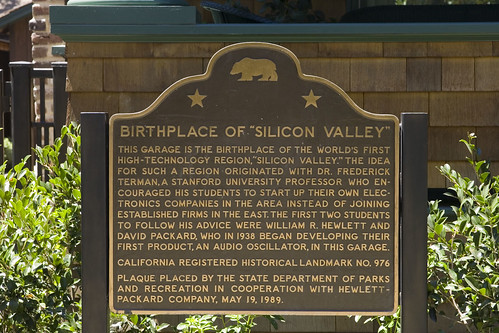
Image from Flickr is by Ian Fuller
Inside view of garage;
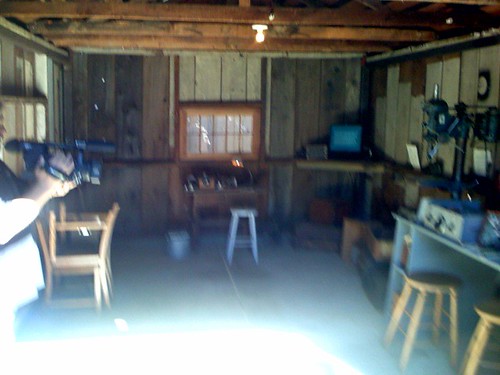
Image from Flickr is by scriptingnews
Source of info and more info: Wikipedia / HP Garage Timeline
World's First Hard Disk, IBM RAMAC 350 - 99 Notre Dame Avenue, San Jose, CA
The research and development of World's first disk storage was done by the research team of IBM's West Coast Laboratory at 99 Notre Dame Avenue, San Jose. Development of disk storage is one of the most historic technological milestone of the digital technology. Prior to its development all the retrieving and processing of the data was done sequentially using punched cards or magnetic tapes. RAMAC ended it all and led to faster and better computers. Invention and subsequent miniaturisation of disk storage (Hard Disk Drive - HDD) is one of the main causes which led to the popularity of home computers amongst the common populace of the World.
Views of early Hard Disk;

Image from Wikimedia Commons is under CC

Image from IBM Archives is Copyright © IBM and included here after due permission.
The first Disk Storage Unit was 60 inches (1.52 metres) long, 68 inches (1.72 metres) high and 29 inches (0.74 metres) deep with a capacity 5 million 7-bit (6-bits plus 1 odd parity bit) characters - about 4.4 megabytes which at that time was considered whopping large. It weighed over a ton, had to be moved by fork lifts.
The building at 99 Notre Dame Avenue was hired by IBM in 1952 for their West Coast laboratory and remained in their possession till 1956 when the research center was moved to 5600 Cottle Road, San Jose. The building presently houses Santa Clara County Superior Court. However being the birthplace of World's first dist storage unit, the building carries plaques mounted by IEEE an ASME to commemorate the event. The City Council is also planning to have a permanent public exhibit, showcasing the development of hard disk drives.
Present Day view;
Image Source: Google Street View
Source of info and more info: IBM Archives / Magnetic Disk Heritage Center / Wikipedia
WYSIWYG and GUI - Xerox PARC, Palo Alto, CA
One of the main reasons of increase in popularity of personal computers among the non-technical persons was development of WYSIWYG (What You See Is What You Get) and GUI (Graphical User Interface) which made working on computers more user friendly by presenting a realistic display on the monitor and also replacing typing of commands with clickable icons/buttons.
The company responsible for developing these features is Palo Alto Research Center Inc. (PARC) formerly Xerox PARC. Founded in 1970 as a division of Xerox Corporation, in 2002, it became an independent but wholly owned subsidiary of Xerox Corporation.
PARC has been responsible for not only development of WYSIWYG (1974) and GUI (1975) but also developed Laser Printing (1971), Ethernet/Distributed Computing (1973), etc.
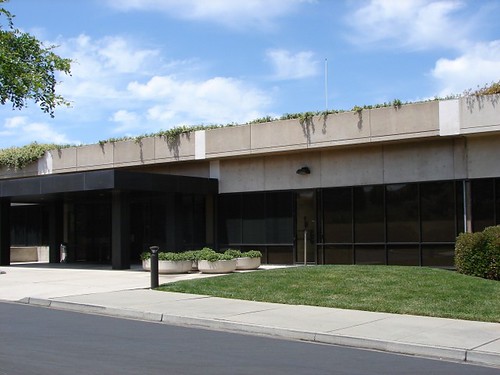
Image from Flickr is by ryry9379

Image Source: Google Street View
Source of info and more info: Xerox PARC milestones / Wikipedia
Microsoft Corporation - 819, Two Park Central Tower, Albuquerque, NM.
There is some confusion regarding the birthplace of the software giant - Microsoft - which had a modest beginning in 1975-1976.
A plaque at 199 California Street NE, Albuquerque, NM. (shown below) says that Microsoft was housed in this site from 1975 to 1979.

Image Source: Google Street View
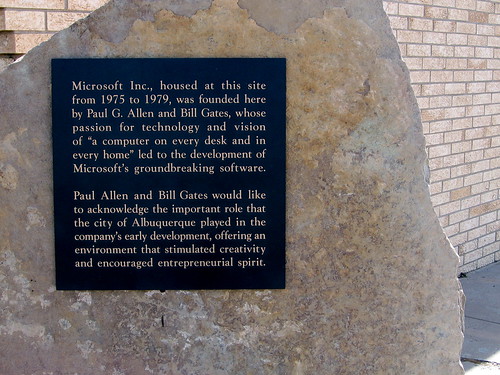
Image from Flickr is by Marcin Wichary
Actually Paul Allan and Bill Gates' first business venture was development of BASIC software for MITS' Altair 8800. MITS which is defunct now had its main office at 6328 Linn Avenue S.E., Albuquerque. On March 1, 1975, Paul Allen joined MITS as director of software. Later he and Bill Gates set up the MITS software department in a little office at 199 California Street NE, at the intersection of Linn Avenue S.E., close to MITS main office. So in a sense one can say that Microsoft was conceived at above location.
However the Company known as Microsoft was born on September 1, 1976 when it took on lease Suite 819, Two Park Central Tower Building, 300 San Mateo Blvd, N.E., Albuquerque, NM, as their official office space. Paul Allen left MITS on November 1, 1976 and joined Microsoft full time and the company was registered on November 26, 1976. Two Park Central Tower Building (shown below) is therefore the real birthplace of Microsoft.

Image Source: Google Street View
Source of info and more info: Channel9.msdn.com (History of Microsoft) 1975 1976 / STARTUP Gallery - Web site of museum conceptualised and funded by Microsoft's co-founder Paul Allen, his sister Jo Allen Patton, and supported by the Bill and Melinda Gates Foundation amongst others.
Apple Inc. - 2066 (formerly 11161) Crist Drive, Los Altos, CA.
Apple Inc. (previously Apple Computer), one of the World's largest multinational dealing/manufacturing consumer electronics, computer software, and personal computers had a modest beginning on April 1, 1976 at 11161 Crist Drive, Los Altos, CA. The proto-type of first low cost PC, Apple-1, was built in a bed room of its co-founder Steve Wozniak. Later Steve Jobs and Steve Wozniak, along with Ronald G. Wayne started using the Garage of the building to assemble their computers.
It is interesting to note that at that time Wozniak was employed with Hewlett Packard and he had to offer their first product (Apple-1) to HP, but no one at HP was interested in it and they obtained legal release from HP to produce and sell the same on their own. In 1983 HP were also the first to introduce home computer (named - Apple Lisa Computer) with a graphical user interface (GUI).
Here are few images of the early Apple-1. Initially Apple was supplying just the mother board and the wooden case shown in ensuing pictures was not part of their supplies.

Image from Flickr is by kevinthoule

Image Source: Google Street View
Source of info and more info: theapplemuseum.com / applemuseum.bott.org
First IBM-PC - IBM Research Center, Boca Raton, Florida.
IBM entered Personal Computer field quite late. Before the launch of its first personal computer - IBM-PC 5150, there were already few manufacturers in the field namely but not limited to Apple, Commodore and Atari etc. and their products were already well known brand name generally within the research labs/technical colleges and video gamers. These personal computers were mainly using BASIC as the programming language.
Release of IBM-PC on August 12, 1981 however changed the entire scenario and indirectly brought a revolution in the World of small office, class rooms and home computing. It was an historic moment. Not only IBM-PC sold many times more than the original estimates of IBM but lack of proprietary components and operating system in IBM's PC coupled with easy availability of Intel's 8088 microprocessor and Microsoft's MS-DOS operating system created an explosion in sales of IBM-Compatibles (or clones) and soon personal computers were within the reach of a common man. In a sense most of the PCs being used today can be called descendents of IBM-PC.

Image from IBM Archives is Copyright © IBM and included here after due permission.
First IBM-PC was developed at IBM's research labs in main plant located on Yamato Rd (NW 51st St) Boca Raton, Florida. IBM later (1996) sold the entire area and it was ultimately acquired by T-REX Management Consortium. The research centre where IBM was born is today known as The Boca Corporate Center and Campus.

Image Source: Google Street View
This post in Google Earth Community has mentioned that IBM research labs where IBM-PC was developed was located at another nearby building, away from main complex. As per my own (re)search on WWW, it is true that IBM did have a separate building known as IBM's Building 051 at 1798 NW Spanish River Blvd. When IBM facilities were closed at Boca Raton this building was donated to the Palm Beach County School District and converted into Don Estridge High Tech Middle School to honour Don Estridge, whose team was responsible for developing the IBM PC. However I couldn't find any supportive information confirming that the IBM research lab which developed first IBM-PC was located the present school building. Further this post by IBeamer in Google Earth Community Forum has confirmed the location at the present Boca Corporate Center and Campus.
Source of info and more info: ibm-history-pc25_birth / ibm5150.net / pcworld.comDell Inc. - Dorm Room 2713, Dobie Center, University of Texas, Austin.
Dell Inc. one of the largest technological corporations in the World had a modest beginning as 'PCs Limited' in room 2713 of Dobie Center of University of Texas, Austin with an initial capital of $1000. Michael Dell launched 'PCs Limited' on May 3, 1984 from his dorm-room and initially sold IBM-PC compatible computers assembled from loosely bought components. Initially Dell sold home PCs under brand name of "Turbo PC". He eliminated the middle man and sold his computers directly to users thereby reducing the cost and also customising it as per the buyers need.
Within a span of two decades the company had a phenomenal growth and reportedly grew faster then any other company including Microsoft. In 1988 the company changed its name to "Dell Computer Corporation" and later to Dell Inc. It is one of the most famous multinational company in the digital technology business and is reportedly the world's second-largest PC maker.
Here is an image of one of the earliest Dell computers on display at Smithsonian's National Museum of American History (NMAH).

A view of Dobie Center;

Image Source: Google Street View
Source of info and more info: Wikipedia
World Wide Web (Hypertext Protocol) - Building # 513 CERN, Geneva, Switzerland
Although internet as a means of computer networking was developed as early 1965 by Advanced Research Projects Agency Network (ARPANET) in USA and the first networking was achieved between the University of California, Los Angeles and the Stanford Research Institute on October 29, 1969, the popularity of Internet took a quantum jump with creation of Hyper Text Transfer Protocol by Tim Berners-Lee and Robert Cailliau, who built the first working prototype of WWW in late 1990/early 1991 at CERN Computer Centre located in building # 513.
The computer centre, building 513, as it looked in June 1972.

The computer centre, building 513, as it looked in June 1972.

Image from CERN Document Server is Copyright © CERN and included here after due permission.
Many persons get confused between the terms Internet and World Wide Web and often assume that these two mean the same thing. This however is not correct. The Internet is a hardware and associated software infrastructure that provides connectivity between computers - sort of global data communications system. In contrast, the WWW is a collection of interconnected documents and other resources (images, videos, databases etc.), linked by hyperlinks with each having a unique ID (URL). However the words 'The Net' are being commonly used as a slang equivalent of WWW.
WWW has literally shrunk the whole wide world and made it into a global village. From a single page created at CERN in 1990 (URL: info.cern.ch), it is estimated by worldwidewebsize.com that, on Aug 11, 2010, there were at least 27.32 billion pages on the World Wide Web and on Aug 18, 2010 there were at least 29.89 billion pages. Thus currently more than 4200 pages are added on WWW every second.
The building has since been modified and the current building can be seen in Google Street View.
Source of info and more info: info.cern.ch / CERN Press Release Mar. 13, 2009 / Wikipedia
Source of info and more info: info.cern.ch / CERN Press Release Mar. 13, 2009 / Wikipedia
Google Inc. - Garage at 232 Santa Margarita, Menlo Park, CA.
Google the search engine giant which has diversified in many other areas and has within a span of few years not only became synonymous with quick and smart search for all types of information/data but has also made an all pervasive impact on most of the Net users. 'Googling' and 'to Google' have become a commonly understood words meaning 'searching' or 'to search' on the Internet (WWW).
Google had a very modest beginning at a small garage which was rented out in September 1998 from Susan Wojcicki. Google's co-founders Lawrence (Larry) Page and Sergey Brin had originally used the Stanford server under the domain google.stanford.edu. Later with the incorporation of their company, Google Inc., on September 4, 1998 they set up their servers at this small garage.
The predecessor of Google was a web crawler called BackRub hosted on Stanford server. However in 1997 Larry Page and Sergey Brin gave it the name Google which rhymed with mathematical 'Googol' representing a huge number 10100 i.e. 1 followed by one hundred zeroes.
Here is a snapshot of Google early web page on Stanford server;
Snapshot of Google early web page on their own (google.com) server;

Google First Server can be seen below;
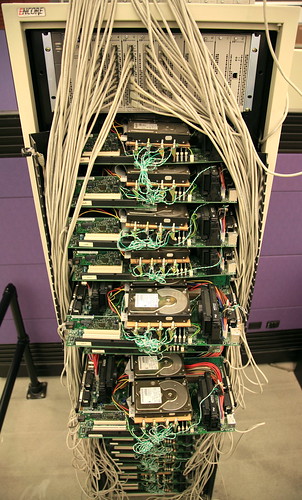
Image from Flickr is by jurvetson
A view of the Google garage at 232 Santa Margarita;

Image from Flickr is by naoyuki_ishitsuka
(Image added on 30/08/2010 after due permission.)
Google later bought the house and has preserved it. However I understand that visitors are not welcome inside.
Edit Note: June 21, 2020
The Garage, known as Susan's Garage, can now be seen in Google Inside View
View location in Google Maps (3D)
Source of info and more info: google.com corporate history / Wikipedia
View location in Google Maps (3D)

No comments:
Post a Comment
Please feel free to write your comments but remember that the same are moderated. So please do not post SPAM comments i.e. your business links here including surrogate links.
Comments containing SPAM are liable for rejection.